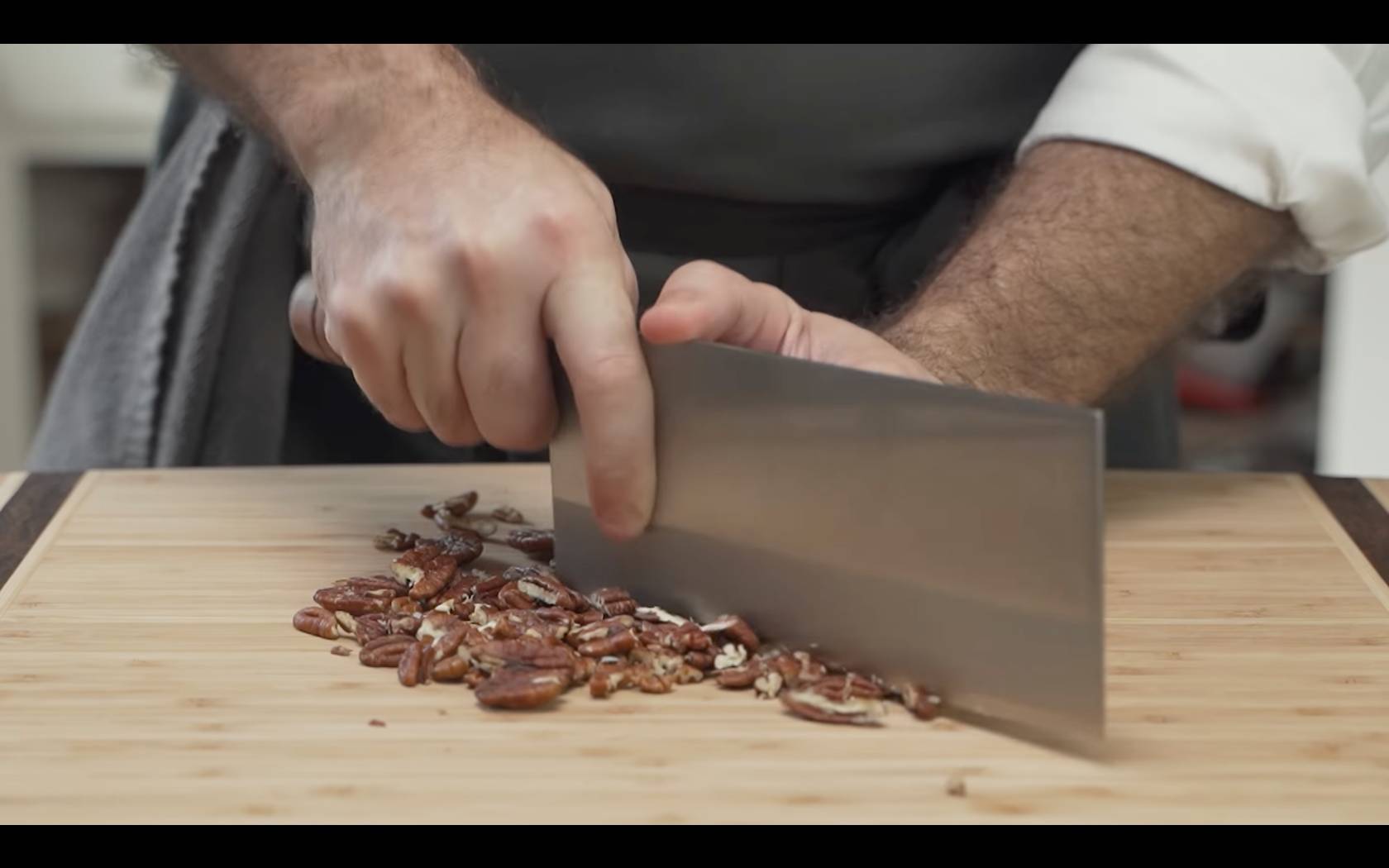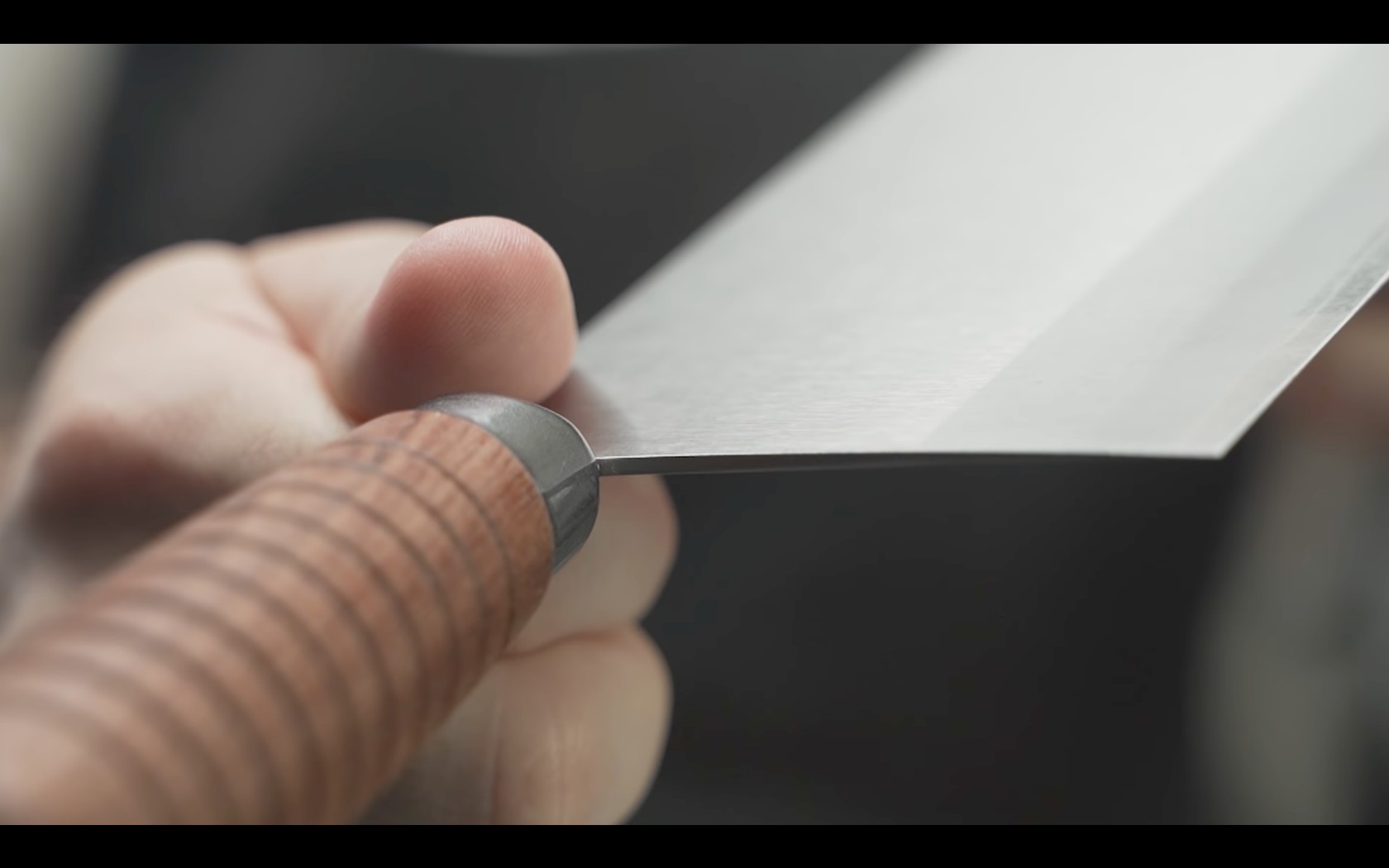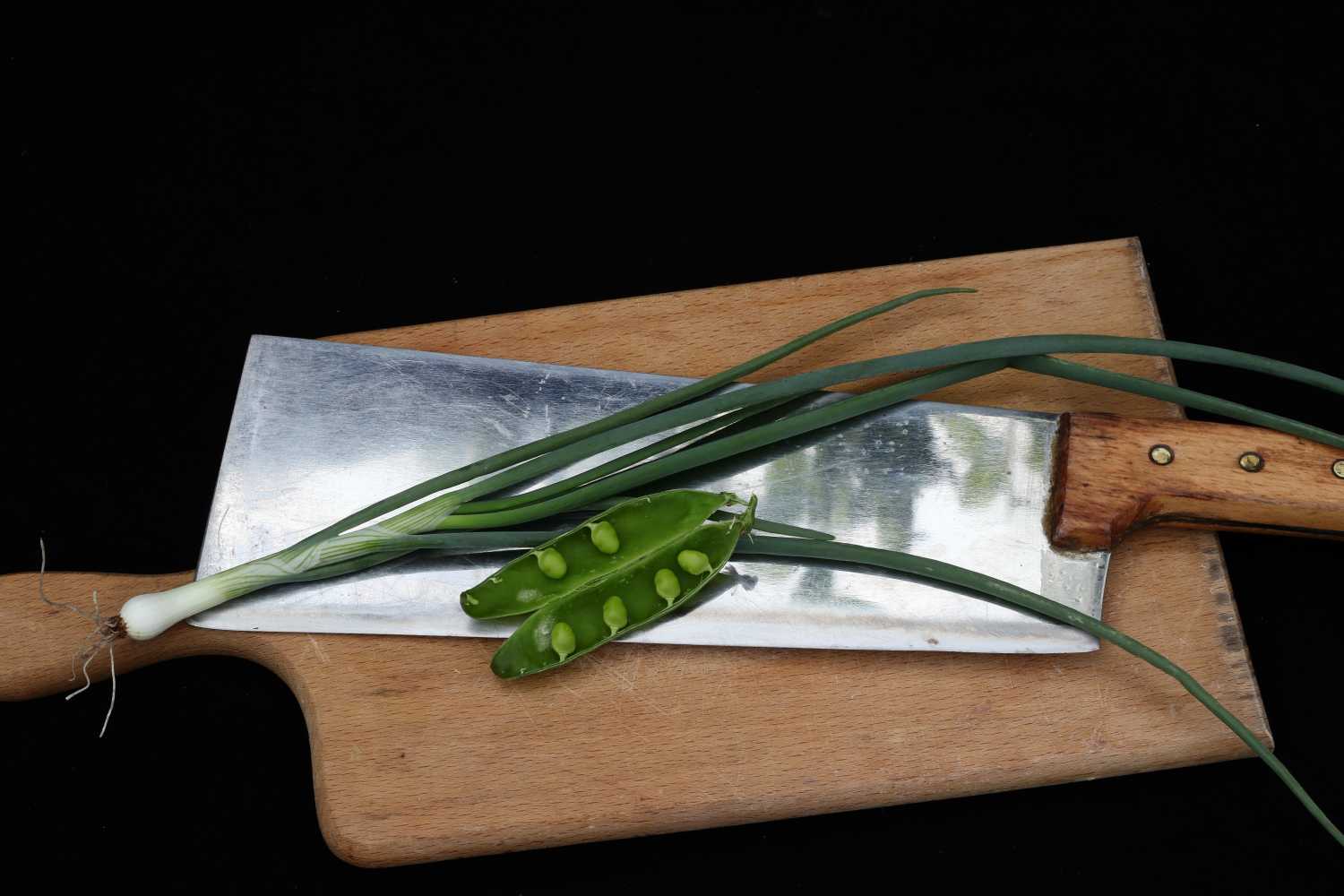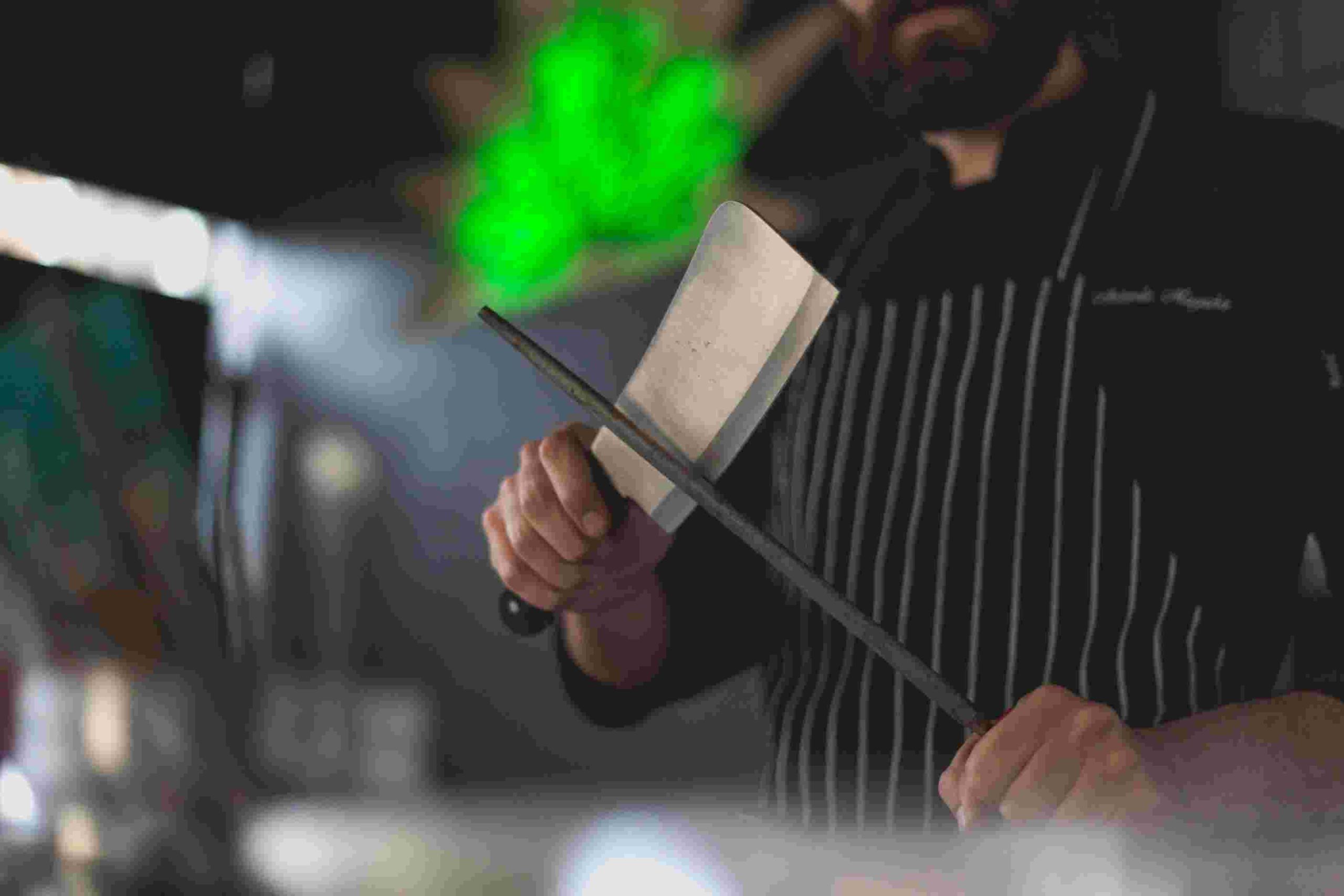If you came across chefs chopping and mincing ingredients with a cleaver-like chef’s knife on social media and wondered what it is – that’s Chukabocho!
Chukabocho is a type of Japanese knife versatile with plenty of uses. It works excellently for slicing, chopping, mincing, and crushing vegetables, fruits, small and medium-sized poultry, and fish. The biggest difference from other chef’s knives is the shape that creates a distinct cutting style. Once you get the hang of it, though, it will be the only all-purpose kitchen knife you’ll need throughout food preparation.
This article will cover everything you need to know about Chukabocho, explain why it’s an excellent all-rounder kitchen knife, and compare it with similar blades.
Table of contents
Origins of Chukabocho
Translating to the Chinese kitchen knife in Japanese, Chukabocho derives from the Cai Dao (Chinese cleaver) knife. This knife is a cleaver-like Chinese chef’s knife featuring a wide blade with a double bevel cutting edge. Both Cai Dao and Chukabocho look similar, but the Japanese adopted the Chinese cleaver and turned this all-purpose knife into their own version.
Japanese knifemakers take advantage of ancient forging techniques unique to them. These add distinct characteristics to the blades they forge. Some of the differences between Cai Dao and Chukabocho come from the forging differences. Even though they are different knives that cut differently, it’s not uncommon to see them displayed as Chukabocho/Cai Dao in knife shops.
Key features

Shape
The primary difference between Chukabocho and any other all-purpose kitchen knife is the shape. Chukabocho has a tall, wide blade profile identical to a butcher’s cleaver. That’s why many refer to this knife as the Chinese cleaver, thanks to its tall, rectangular shape.
However, using Chukabocho as if it was a cleaver to cut down large cuts of meat can have disappointing results. Chukabocho is suited for general tasks like slicing and chopping, not cutting through bones, as it isn’t a cleaver.
Length and weight
The blade length of Chukabocho is between 7 and 10 inches. As the blade’s length increases, so does the weight, but the excess mass has some benefits. Chukabocho’s average weight varies significantly, and it can be anywhere from 350 grams to 900 grams. The heavy blade with a sharp, sturdy double bevel cutting edge allows easy push cutting and slicing.
A 7.5-inch Chukabocho is the most common size. This length is suitable for many home cooks and professionals alike. If you’re chopping ingredients in a commercial kitchen, getting a lengthier Chukabocho could be better. It would allow you to process more foods at once.
Edge

Chukabocho has a double bevel edge that’s mostly straight. Some Chukabocho knives feature a slight curve at the tip and heel. This edge design invites the cook to chop ingredients by push cutting with a slight rocking at the end. While it’s a distinct cutting style that you’ll need to get used to, it’s easy on the wrists.
The cutting style of Chukabocho is similar to kiritsuke, santoku, or any other Japanese-style knife that has a straight edge.
While most western knives also have a double bevel edge, Chukabocho’s grind angle is more acute at around 10 to 15 degrees. This grind angle allows for a razor-sharp yet more delicate edge. This explains why Chukabocho isn’t suitable for robust work, such as cutting large bones or highly dense ingredients like frozen foods.
Handle design
There are two main types of handles in Chukabocho knives: wa-handle (traditional handle) and western handle – same as any other Japanese knife.
You can find Chukabocho knives with both handles. It comes down to personal preference to pick which one you’ll have on a Chukabocho. Yet, if you’re accustomed to rocking the blade over the ingredients, getting a Chukabocho equipped with a western-styled handle would be more practical.
For anything else, a wa-handle that’s either round or octagonal would serve the purpose better. It’s easier to operate with a straight-edged knife fitted with a traditional Japanese handle when slicing ingredients by thrust cutting. This technique refers to moving the blade up and down and cutting with the heel portion of the blade.
Parts of a Chukabocho

- Rectangular tip: Chukabocho’s tip is rectangular and extremely sharp. You can employ the tip when making slits and precision cuts like any other knife with a pointy end. While you can use the sharp tip for many tasks, the angle you hold the knife will be different from a standard chef’s knife. Additionally, the blade’s weight can be exhausting to clasp when using the tip for prolonged periods.
- Thick spine: Chukabocho features a relatively thick spine for a standard chef’s knife. The spine adds weight to the knife, making it easier to glide it through ingredients.
- Bolster: Some Chukabocho knives come with a bolster. The Chukabocho knives with bolsters are more prevalent with western manufacturers. The bolster serves as a balance point for knives with similar blade profiles. If you prefer heavier knives, a Chukabocho with a bolster is a better choice than another without one.
- Slightly curved edge: Most Chukabocho knives have a slight curve to their belly. The blade gradually curves from the belly to the heel and tip. This trait allows Chukabocho to cut ingredients by utilizing different cutting styles, from thrust cutting to rocking the blade.
Chukabocho uses

Chukabocho is an all-purpose knife. You can utilize this knife in every aspect of preparing dishes. Although it has an entirely different look than most people picture an all-purpose kitchen knife, handling everything with a Chukabocho is effortless.
However, there is a noticeable learning curve with Chukabocho if you’re not familiar with this blade profile. You’ll need to do lots of practice to feel comfortable with the knife. Nonetheless, with a steady routine and proper technique, you can deal with all your cutting needs using a Chukabocho in no time.
Recommended multi-purpose knives
Get 11% off and free shipping – limited time only!
Chukabocho cutting technique
Chukabocho is very different from a traditional chef’s knife. It has a completely different blade design that offers unique functions. A large portion of the cutting edge makes contact with the board when cutting ingredients. It’s the same with santoku or kiritsuke. If you’ve been using these Japanese knives, it won’t feel strange.
The wide blade requires less travel when thrust cutting. This ensures fast slices and chops. You can use Chukabocho to chop pounds of vegetables quickly by just moving the knife up and down over the ingredients.
The most efficient and perhaps the easiest method to slice and chop ingredients with a Chukabcho is push cutting. Due to the slight curvature of the edge, you can release the blade from the cutting board with a subtle rocking motion. This cutting technique will enable you to slice and chop ingredients fast.
As you get acquainted with this cutting style – sort of like a combination of Japanese and western ways – you’ll be able to cut down ingredients quickly. Here are additional unique ways you can employ a Chukabocho in the kitchen.
Pounding and tenderizing meat
The large surface area of Chukabocho is ideal for lightly pounding meats to flatten them. Use the knife to gently beat the animal protein or press the blade down. It will provide a fast and efficient way to tenderize boneless meats no matter how.
Transferring ingredients from cutting board to pot or wok
The large blade isn’t only good for tenderizing meat. It’s the perfect tool to transfer everything you’ve cut from the board to the pot. Chop down and slice ingredients and easily scoop large portions off the cutting board. Additionally, the broad blade profile helps prevent slices from sticking to the knife and enables better food release.
Using the sharp tip to make incisions
The sharp square tip of Chukabocho is ideal for making incisions and slits. You won’t find yourself looking for another blade, though it can get tiring to make slits with a Chukabocho due to the weight. It’s an ideal knife to make slits on vegetables as you slice for a faster cooking time.
Crushing small vegetables
The blade’s width is ideal for crushing small vegetables like garlic and ginger to add flavor to the dishes. You can also use Chukabocho to crack nuts with soft shells.
Chukabocho vs. Chinese cleaver

While many cooks use Chukabocho and Chinese cleaver interchangeably to refer to each other, they aren’t the same. The Chinese cleaver is the Cai Dao, whereas the Chukabocho is the knife the Japanese adopted from the Chinese.
The difference between Chukabocho and Chinese cleaver is nonexistent to the naked eye. Once you use both knives, though, it will feel very different. Chukabocho is made from better steel with a higher carbon amount than Cai Dao. A good portion of Chinese cleavers are also mass-produced stamped knives. These make Chukabocho harder, and sharper and enable it to hold the sharp edge for longer.
Like many other Japanese knives, the Chukabocho’s angle is narrower than Cai Dao for finer slicing. Chinese cleaver’s bevel angle is more or less the same as western-styled knives for better durability. This makes the Chinese cleaver suitable for robust work. After all, it’s a cleaver.
Chukabocho will suffice for any general-purpose task, from slicing thin strips of vegetables to chopping. They are also suitable for cutting poultry with small and hollow bones like ducks and chicken. Take a Chinese cleaver when cutting bones and dense ingredients; Chukabocho for anything else.
Chukabocho vs. Nakiri
Nakiri is the go-to kitchen knife to chop, slice, and mince vegetables and fruits. Chukabocho is more versatile than Nakiri as it is also ideal for cutting animal protein. Not to say that you can’t do these with Nakiri, but Chukabocho is more suitable.
Both knives have a double bevel edge, but Chukabocho is sturdier. Nakiri is more comparable to Usuba. Both Japanese knives are used for cutting vegetables and fruits. As Chukabocho has a wider blade, it’s heavier than Nakiri.
If you plan to have a dedicated rectangular shaped knife to cut vegetables and fruits, Nakiri is the ideal choice. If you want to get more out of your knife than just cutting veggies and fruits, Chukabocho is better.
Chukabocho vs. Gyuto
All-rounder knives are great for many things without specializing in one particular area. Both Gyuto and Chukabocho are all-purpose knives. This is what they have in common – but with Gyuto more focused on cutting red meat and Chukabocho on vegetables and fruits.
There are significant differences between Chukabocho and Gyuto. The way you’ll operate with either knife is very distinguishable due to the blade design and weight differences. You can cut ingredients the same as any other western chef’s knife with Gyuto.
Chukabocho will take more time to master. Understanding and familiarizing yourself with the cutting technique mentioned above will help you pick up your pace with a Chukabocho.
It will be challenging to familiarize yourself with Chukabocho if you’ve been utilizing a standard chef’s knife all your life. The same applies the other way around for someone operating their kitchen with a Chukabocho or a knife equivalent to it. These also go hand-in-hand with Chukabocho and western-style chef’s knives.
How to care for a Chukabocho
Caring for a Chukabocho is not much different than any other kitchen knife. However, when you have a blade as large as this, there are several factors to consider when upkeeping a Chukabocho. Here is how to maintain one.
Storage
It’s vital to store your knife arsenal properly to prevent damaging them and accidents they might cause. Chukabocho is a gentle giant. It has a delicate edge that enables fine slicing, despite appearing like a bully. Storing Chukabocho with the rest of your knives might not be ideal due to size.
The safest and most efficient way to store larger blades is by utilizing magnetic blocks or strips. There are also various other storage methods that work perfectly for big kitchen knives, given you have enough space.
Regardless of how and where you keep knives, they should have enough room between them, and the blades shouldn’t be touching each other. The most common reason leading to damaging knives other than incorrect use is wrong storage methods. Store your Chukabocho keeping these in mind, and it will serve you for years down the line.
Cleaning

Like all knives, always hand-wash your Chukabocho. Avoid dishwashers at all costs. The high heat and harsh chemicals make the handle wear down quickly and can lead to oxidizing the blade.
Once cleaned, storing the knife dry is just as vital to prevent oxidation. Depending on the steel’s ability to resist corrosion, keeping the blade dry when you’re not using it is also essential.
For example, stainless steels with proven rust resistance won’t mind being left in the sink dirty or wet for brief periods. It’s a rather different case with carbon steels or another with inadequate corrosion resistance. Treat cleaning as a duty at all times for your kitchen knives, not just after using them.
Sharpening
Chukabocho is a double bevel knife, as mentioned above. You’ll need to sharpen both sides of the blade using a sharpening stone. Using any sharpening stone will give optimal results, but whetstones work the best.
When sharpening, start with the coarsest side of the whetstone to give it an initial sharpness and polish using the higher-grit side. You can then test to see how sharp the blade has become. Attempting to cut paper is the standard way to test the sharpness. If it cuts through without tearing it, you’re good to go. Learn how to sharpen kitchen knives using a whetstone.
Since maintaining the same angle throughout sharpening is vital and Chukabocho has a large blade, keeping it still might pose a challenge. Consider using an angle guide to hold the blade stable as you sharpen.
Chukabocho’s large blade might pose a challenge in holding it still as you sharpen. Since maintaining the same angle is vital for achieving a sharp edge, consider using an angle guide to hold the blade.
Ending
Overall, Chukabocho is an adaptable knife you can use throughout entire food preparation. It’s the perfect starter for experienced cooks that want to use big knives in the kitchen. A step up from Chukabocho would be our hand forged chef knife.
Even though newbies to a knife like this may have to spend months to get comfortable, Chukabocho offers unique ways to slice and chop. Learn more about other interesting knives on HDMD Knives Blog.












